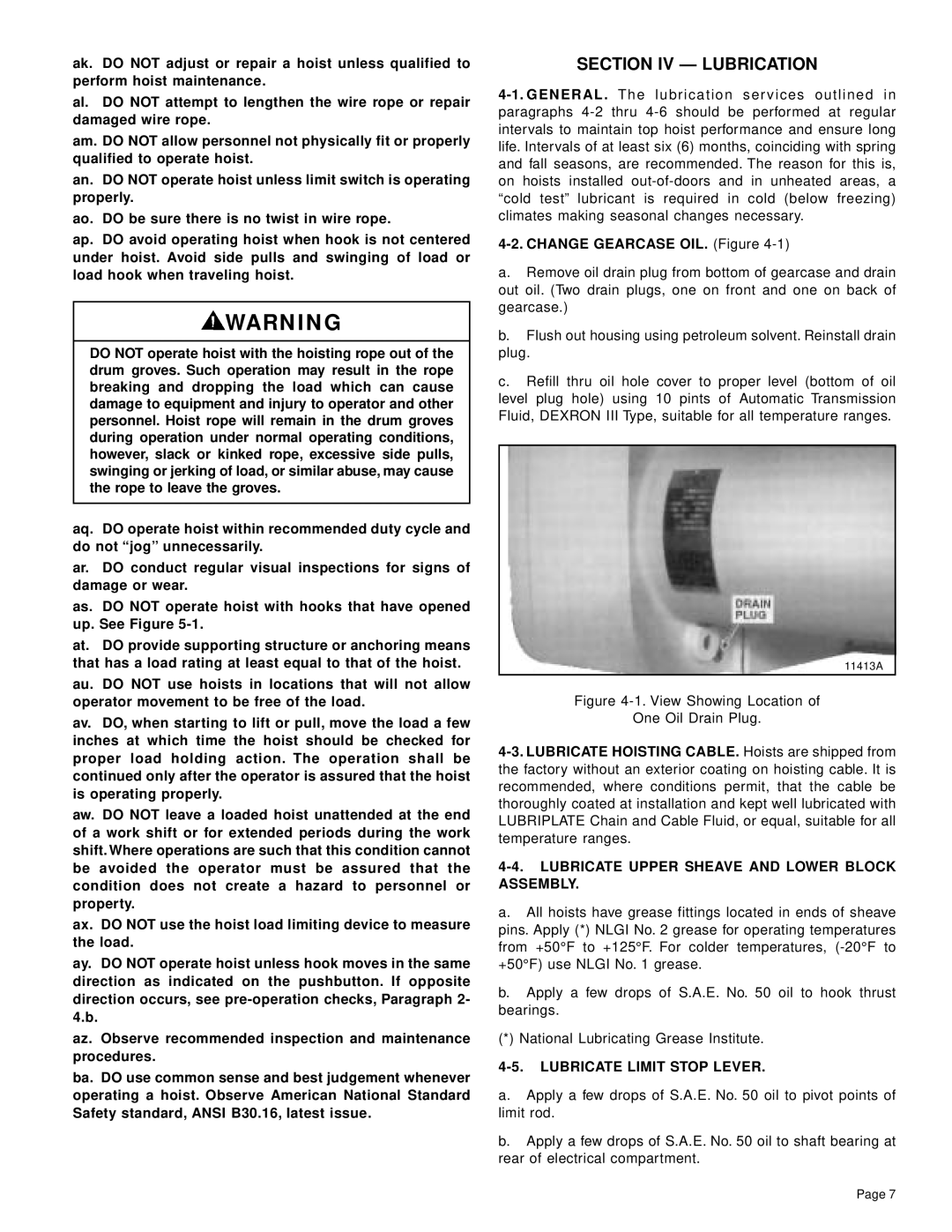
ak. DO NOT adjust or repair a hoist unless qualified to perform hoist maintenance.
al. DO NOT attempt to lengthen the wire rope or repair damaged wire rope.
am. DO NOT allow personnel not physically fit or properly qualified to operate hoist.
an. DO NOT operate hoist unless limit switch is operating properly.
ao. DO be sure there is no twist in wire rope.
ap. DO avoid operating hoist when hook is not centered under hoist. Avoid side pulls and swinging of load or load hook when traveling hoist.
![]() WARNING
WARNING
DO NOT operate hoist with the hoisting rope out of the drum groves. Such operation may result in the rope breaking and dropping the load which can cause damage to equipment and injury to operator and other personnel. Hoist rope will remain in the drum groves during operation under normal operating conditions, however, slack or kinked rope, excessive side pulls, swinging or jerking of load, or similar abuse, may cause the rope to leave the groves.
aq. DO operate hoist within recommended duty cycle and do not “jog’’ unnecessarily.
ar. DO conduct regular visual inspections for signs of damage or wear.
as. DO NOT operate hoist with hooks that have opened up. See Figure
at. DO provide supporting structure or anchoring means that has a load rating at least equal to that of the hoist.
au. DO NOT use hoists in locations that will not allow operator movement to be free of the load.
av. DO, when starting to lift or pull, move the load a few inches at which time the hoist should be checked for proper load holding action. The operation shall be continued only after the operator is assured that the hoist is operating properly.
aw. DO NOT leave a loaded hoist unattended at the end of a work shift or for extended periods during the work shift. Where operations are such that this condition cannot be avoided the operator must be assured that the condition does not create a hazard to personnel or property.
ax. DO NOT use the hoist load limiting device to measure the load.
ay. DO NOT operate hoist unless hook moves in the same direction as indicated on the pushbutton. If opposite direction occurs, see
az. Observe recommended inspection and maintenance procedures.
ba. DO use common sense and best judgement whenever operating a hoist. Observe American National Standard Safety standard, ANSI B30.16, Iatest issue.
SECTION IV — LUBRICATION
4-2. CHANGE GEARCASE OIL. (Figure 4-1)
a.Remove oil drain plug from bottom of gearcase and drain out oil. (Two drain plugs, one on front and one on back of gearcase.)
b.Flush out housing using petroleum solvent. Reinstall drain plug.
c.Refill thru oil hole cover to proper level (bottom of oil level plug hole) using 10 pints of Automatic Transmission Fluid, DEXRON III Type, suitable for all temperature ranges.
11413A
Figure 4-1. View Showing Location of
One Oil Drain Plug.
4-4. LUBRICATE UPPER SHEAVE AND LOWER BLOCK ASSEMBLY.
a.All hoists have grease fittings located in ends of sheave pins. Apply (*) NLGI No. 2 grease for operating temperatures from +50°F to +125°F. For colder temperatures,
b.Apply a few drops of S.A.E. No. 50 oil to hook thrust bearings.
(*) National Lubricating Grease Institute.
4-5. LUBRICATE LIMIT STOP LEVER.
a.Apply a few drops of S.A.E. No. 50 oil to pivot points of limit rod.
b.Apply a few drops of S.A.E. No. 50 oil to shaft bearing at rear of electrical compartment.
Page 7
